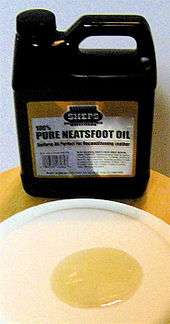Neatsfoot oil
Neatsfoot oil is a yellow oil rendered and purified from the shin bones and feet (but not the hooves) of cattle. "Neat" in the oil's name comes from an Old English word for cattle.[1] Neatsfoot oil is used as a conditioning, softening and preservative agent for leather. In the 18th century, it was also used medicinally as a topical application for dry scaly skin conditions.

"Prime neatsfoot oil" or "neatsfoot oil compound" are terms used for a blend of pure neatsfoot oil and non-animal oils, generally mineral or other petroleum-based oils.
Characteristics
Fat from warm-blooded animals normally has a high melting point, becoming hard when cool, but neatsfoot oil remains liquid at room temperature. This is because the relatively slender legs and feet of animals such as cattle are adapted to tolerate and maintain much lower temperatures than that of the body core, using countercurrent heat exchange in the legs between warm arterial and cooler venous blood. Other body fat would become stiff at these temperatures. This characteristic of neatsfoot oil allows it to soak easily into leather.
Modern neatsfoot oil is still made from cattle-based products, and is sometimes criticized for a tendency to oxidize and therefore contribute to the deterioration of leather.[2] This formulation does darken leather, which means that use on light-colored leather is likely to change its color. If mineral oil or other petroleum-based material is added, the product may be called "neatsfoot oil compound".[3] Some brands have also been shown to be adulterated with rapeseed oil, soya oil, and other oils.[4] The addition of mineral oils may lead to more rapid decay of non-synthetic stitching or speed breakdown of the leather itself.[3][5][6]
Manufacture
After cattle are slaughtered, the feet and lower leg bones, including the skin but not the hooves, are boiled. The oil that is released is skimmed off, filtered, and pressed. The first pressing is the highest grade; the second pressing produces a lower grade oil and a solid press cake or stearin product.[1]
Uses
Neatsfoot oil is used on a number of leather products, although it has been replaced by synthetic products for certain applications. Items such as baseball gloves, saddles, horse harnesses and other horse tack can be softened and conditioned with neatsfoot oil.
If used on important historical objects, neatsfoot oil (like other leather dressings) can oxidize with time and contribute to embrittling.[7] It also may leave an oily residue that can attract dust. On newer leather, it may cause darkening (even after a single application), thus may not be a desirable product to use when the maintenance of a lighter shade is desired. Neatsfoot oil has greater utility for routine use on working equipment.
Neatsfoot oil is often used to oil sign-writers' brushes that have been used in oil-based paint, as this oil is non drying and can be easily washed out with solvent at any time. Oiling the brushes reduces the buildup of pigment in the ferrule, the metal part that many brushes have to hold the hairs in place.
Neatsfoot oil of the highest grade is used as a lubricant.[1] It is used in metalworking industries as a cutting fluid for aluminium. For machining, tapping and drilling aluminium, it is superior to kerosene and various water-based cutting fluids. The fat left over from the second pressing process, a solid stearin, is used for making soap.[1]
See also
- Animal glue
- Dippel's oil, another oil, derived from bone
- Hoof glue
- Mink oil, alternative leather treatment
- Saddle soap, leather cleaning and conditioning
References
- "Neat's_foot oil." Encyclopædia Britannica, 2014
- Neatsfoot Oil Ingredients | healthfully.com
- Active Ingredients - HorseChannel.com
- McCrady, E. (1985) Leather Conservation News 2(1) 7, reprinted from Abbey Newsletter, October 1984
- "Tack Repair and Maintenance" [Accessed April 15, 2015]
- "Recommended Leather Care," accessed August 1, 2009 (broken link)
- Canadian Conservation Institute, Note 8/2: Care of Alum, Vegetable and Mineral Tanned Leather